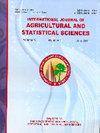Diversification of Rice System: A Sustainable Livelihood for Rice Farming Households in Indramayu District, West Java, Indonesia
IF 0.1
Q4 AGRICULTURE, MULTIDISCIPLINARY
International Journal of Agricultural and Statistical Sciences
Pub Date : 2024-06-01
DOI:10.59467/ijass.2024.20.73
引用次数: 0
Abstract
Agricultural development is a challenge and a way for sustainable livelihoods considering that increasingly narrow agricultural land causes agricultural productivity to decline. The rice diversification system is a solution to the potential byproducts of rice and cattle. The purpose of this research is to explain rice system diversification in increasing farming productivity as an alternative solution. There were two secondary dataused. Rice production and beef cattle production were from the Central Statistics Agency in West Java Province and Indramayu district (2013-2017). The development of beef cattle was supported by the Organic Fertilizer Processing Unit program (2013-2017). The secondary data were analyzed descriptively. The results of this study were positive beef cattle population growth of 18.43 percent during the period 2013-2017, the average number of beef cattle per year as much as 11,012 tails, the average amount of beef cattle manure per year in solid form as much as 116,943,192 tons and liquid as much as 55,894,882 liters and the population of beef cattle still needs to be increased because the amount of solid manure of freshly available beef cattle could be absorbed as much as 3.35 percent for increased productivity of rice fields. Indonesian government assistance was very much needed by rice farmers groups in carrying out a rice diversification system through the Organic Fertilizer Processing Unit program. Furthermore, the potential for rice straw and cattle livestock to become additional income and new sustainable livelihoods for rural farming households.. KEYWORDS :Diversification, Farming productivity, Rice system, Livelihood sustainability, Farmer household.水稻系统多样化:印度尼西亚西爪哇 Indramayu 区水稻种植户的可持续生计
考虑到日益狭窄的农业用地导致农业生产率下降,农业发展是一项挑战,也是实现可持续生计的途径。水稻多样化系统是解决水稻和牛潜在副产品的一个办法。本研究的目的是解释水稻系统多样化在提高农业生产率方面的作用,以此作为一种替代解决方案。研究使用了两种二手数据。大米产量和肉牛产量来自西爪哇省中央统计局和因德拉马尤县(2013-2017 年)。肉牛的发展得到了有机肥加工单位计划(2013-2017 年)的支持。对二手数据进行了描述性分析。研究结果表明,2013-2017 年期间,肉牛数量正增长 18.43%,年均肉牛数量达 11,012 头,年均肉牛固体粪便量达 116,943,192 吨,液体粪便量达 55,894,882 升。稻农团体非常需要印尼政府的援助,以通过有机肥料加工单位计划实施水稻多样化系统。此外,稻草和牲畜饲养有可能成为农村农户的额外收入和新的可持续生计。关键词:多样化、农业生产力、水稻系统、生计可持续性、农户。
本文章由计算机程序翻译,如有差异,请以英文原文为准。
求助全文
约1分钟内获得全文
求助全文
来源期刊
自引率
66.70%
发文量
4
期刊介绍:
Information not localized

 求助内容:
求助内容: 应助结果提醒方式:
应助结果提醒方式:


